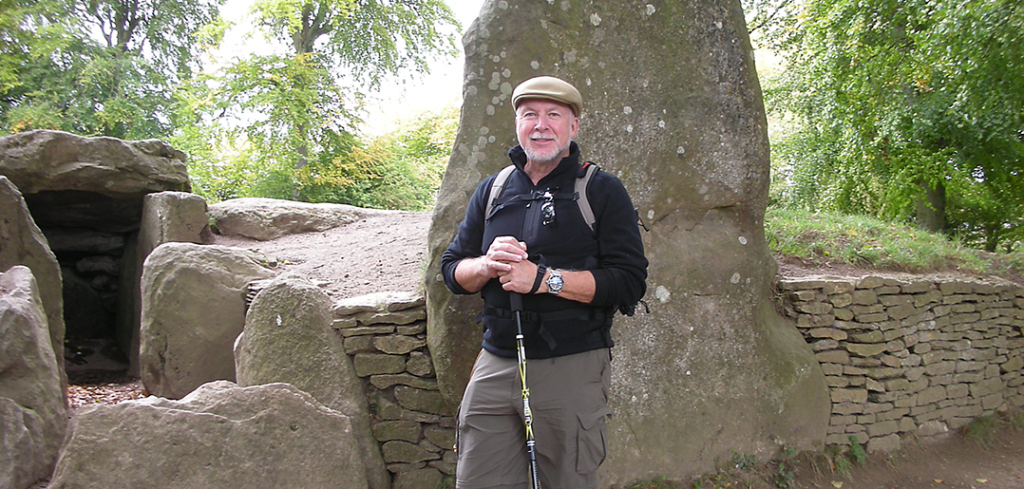“You know the field where Walsh Library is today?” he asks. “I used to climb over the fence to play football with my friends when I was in third or fourth grade.”
Growing up in the Bronx, Blount was always aware of Fordham, and his family’s ties to the University have gotten stronger over the years.
He attended a day camp on campus before attending Fordham Prep and Fordham College at Rose Hill. His mother, Barbara Blount, GSAS ’79, and two of his daughters, Veronica Blount, FCRH ’93, and Ciara Blount, FCLC ’09, also attended Fordham.
After graduating, Blount joined the Marines and earned an MBA from Pepperdine University while stationed at a base in California. Now a self-proclaimed “serial entrepreneur,” he heads the Center for the Study of Financial Market Evolution, a nonprofit group that focuses on building bridges between financial institutions and regulators.
Blount mostly splits his time between Phoenix and Washington, D.C., where his center is located, and travels to New York City and abroad frequently. But although he no longer lives “in the shadow of Keating Hall,” as he describes his childhood home, he often thinks of Fordham on his travels.
It was on a trip to England in 2011 that Blount came up with the idea for Fordham’s Regulatory Outreach for Student Education (ROSE) program. Blount had read about the Ridgeway Trail, a 5,000-year-old Neolithic trail, a few years before, and decided he needed to see it for himself.
As he was hiking the trail, he came to a realization.
The article he had read “positioned it as a defensive trail, connecting prehistoric forts,” Blount says. “As a former Marine, I’m interested in those kinds of things. But I was also an English and economics double major, and I was interested in how the trail connected market towns. So while hiking I kept thinking about all the people that would have taken this route as they were going to market, or going to negotiate for benefits with priests in nearby towns.”
The more Blount thought about the travelers who had come before him, the more he started to see a connection to the modern world of financial regulation.
“We do the same thing now,” he says. “We go to Washington, to our capital, from New York City, and we ask for a break or for relief. So we’ve been traveling to negotiate for a very long time. And being the tired traveler puts you at a disadvantage in those negotiations.”
Blount, who was already a Fordham scholarship supporter, an active member of several alumni chapters, and part of the President’s Council Executive Committee, thought about how students often don’t understand the regulatory negotiation and travel components of working in the financial industry until they experience them for themselves. So he pitched the ROSE program.
In its first year, the ROSE program brought a group of about 20 students down to Washington, D.C., for one day. Blount funded the trip and organized meetings with representatives from the Securities and Exchange Commission, the Treasury, and the Federal Reserve, where the students presented comment letters they had prepared in response to newly proposed regulations.
Now entering its fifth year, the ROSE program has been so successful that it has become a for-credit class taught by Chris Meyer, PhD, a clinical assistant professor of management systems at the Gabelli School of Business.
Meyer works with Blount to choose two newly proposed pieces of financial regulation each year. The students, who are from several of Fordham’s undergraduate and graduate schools, then attend lectures on the topics, hear from alumni guest speakers, and split into teams to write responses. A panel of alumni judges chooses the best response, and the other comment letters are consolidated into a task force report. The two responses are then presented to regulators in D.C. and submitted to the Financial Stability Board in Switzerland.
Fordham students’ comment letters have been chosen and posted online every year since the ROSE program’s inception.
“It’s very unusual for students to get to present their own ideas on a current and significant topic and then get feedback,” Meyer says. “There are lots of financial trading simulations and investment clubs, but this is something where students are truly interacting with the outside world. And they got to take selfies in [Federal Reserve Chair] Janet Yellen’s chair.”
Blount is still an integral part of the course and the trip, helping make connections with other alumni and providing “really valuable expertise and coaching,” Meyer says. “He just puts a lot of time and energy into the program and the school.”
For Blount, the growing program is important in multiple ways. Financial regulation is a “highly charged political issue right now,” he says, “and many positions are diametrically opposed. Finding balance is important. These students all plan to get involved in the industry, so they have a dog in the fight here. They should be listened to.”
He’s also thrilled he’s found another way to give back to his alma mater. “I think you have to give back. Give money if you can, but anyone can give back. Every alumnus has experiences that can benefit students and individuals,” Blount says.
“We haven’t even scratched the surface of what we can do as a community.”

